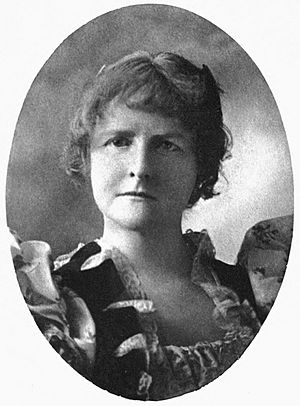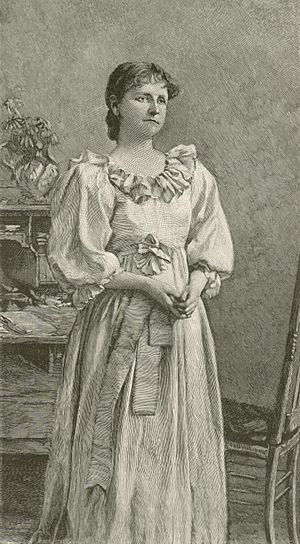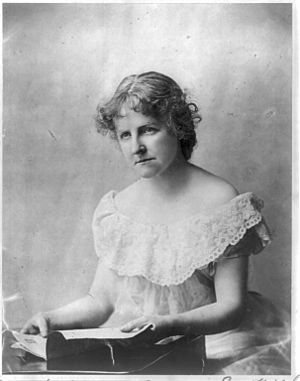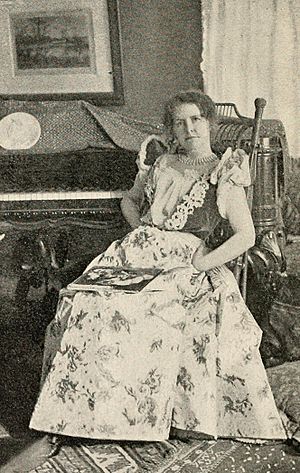Mary Eleanor Wilkins Freeman facts for kids
Mary Eleanor Wilkins Freeman (born October 31, 1852 – died March 13, 1930) was an important American writer from the late 1800s and early 1900s. She is famous for her short stories and novels, especially those about life in New England. Her stories often showed the strength and challenges faced by women during her time.
Contents
Mary E. Wilkins Freeman's Life Story
Early Life and Family
Mary Eleanor Wilkins Freeman was born in Randolph, Massachusetts, on October 31, 1852. Her parents were Eleanor Lothrop and Warren Edward Wilkins. They were very strict about their religion, which was Congregationalist. This strict upbringing influenced some of her later stories.
In 1867, when Mary was about 15, her family moved to Brattleboro, Vermont. She finished high school there. Later, she attended Mount Holyoke College for one year, from 1870 to 1871. She also studied at Glenwood Seminary.
Challenges and Becoming a Writer
In 1873, her family's business failed, and they moved back to Randolph, Massachusetts. Three years later, Mary's mother passed away. Mary then changed her middle name to "Eleanor" to honor her mother.
In 1883, her father died suddenly. Mary was left without close family and with very little money. She moved in with a friend, Mary J. Wales, in Randolph. At this point, she started writing as her only way to earn money.
Marriage and Later Years
In 1892, Mary met Dr. Charles Manning Freeman in Metuchen, New Jersey. He was a doctor, seven years younger than her. They got married on January 1, 1902, after many years. After her marriage, she officially became "Mary E. Wilkins Freeman" and asked her publisher, Harper's, to use this name.
The couple built a home in Metuchen. Mary became well-known in her town for her writing. Sadly, her husband faced mental health challenges and was admitted to a hospital. They legally separated a year later. When he died in 1923, he left most of his money to his chauffeur, not to Mary.
In April 1926, Mary Freeman received a special award called the William Dean Howells Medal. This award was for her amazing fiction writing from the American Academy of Arts and Letters.
Mary Freeman passed away from a heart attack in Metuchen on March 15, 1930. She was 77 years old. She was buried in Hillside Cemetery in Scotch Plains, New Jersey.
Growing Up and Family Life
As a teenager, Mary found herself caught between wanting her mother's love and not wanting to be like her mother. Her mother wanted her to do household chores, but Mary preferred reading. She often avoided kitchen work, even when disciplined.
Mary's sister, Anna, was different. Anna happily did domestic work and met her parents' expectations. Mary, however, quietly resisted these expectations. She continued to resist traditional housework throughout her life. Her famous story, "The Revolt of Mother," seems to be a tribute to her mother's hard work, which Mary had not always valued.
Mary E. Wilkins Freeman's Writing Career
Mary Freeman started writing stories and poems for children when she was still a teenager. She did this to help support her family, and her writing quickly became successful. Her career as a short story writer began in 1881. She won first place in a contest with her story "The Ghost Family." She also wrote supernatural stories that mixed everyday life with spooky elements. These stories became very influential.
Most of her best-known work was written in the 1880s and 1890s, while she lived in Randolph. She published more than 20 books of short stories and novels. She is most famous for two collections of stories: A Humble Romance and Other Stories (1887) and A New England Nun and Other Stories (1891). Her stories often focused on life in New England. She is also remembered for her novel Pembroke (1894). She even wrote a chapter for a collaborative novel called The Whole Family (1908).
Showing Strong Female Characters
Through her different types of writing, Mary Wilkins Freeman showed her beliefs as a feminist. During her time, she did this in unique ways. For example, she did not make her female characters weak or always needing help, which was common in books then.
Characters like Louisa in her short story “A New England Nun” challenged common ideas about women's roles and relationships in society. Also, her short story “The Revolt of 'Mother'" showed the difficulties faced by women in rural areas and their roles in families. This story helped start discussions about the rights of rural women. It also inspired other writings about how rural women often had little control over family money.
An opera called The Village Singer was created from one of Freeman's short stories. It was first performed in 1979.
While she wrote many books, Mary Freeman is mainly remembered for her first two story collections: A Humble Romance and Other Stories (1887) and A New England Nun and Other Stories (1891). Her novel Pembroke (1894) is also very important.
List of Mary E. Wilkins Freeman's Works
- Decorative Plaques (1883)
- The Adventures of Ann (1886)
- A Humble Romance and Other Stories (1887)
- A New England Nun and Other Stories (1891)
- The Revolt of Mother (1891)
- Young Lucretia and Other Stories (1892)
- The Pot of Gold and Other Stories (1892)
- Jane Field (1892)
- Giles Corey (1893)
- Pembroke (1894)
- Comfort Pease and Her Gold Ring (1895)
- Madelon (1896)
- Once Upon A Time (1897)
- Jerome, a Poor Man (1897)
- Silence, and other Stories (1898)
- People of Our Neighborhood (1898)
- of Our Neighbours (1898)
- In Colonial Times (1899)
- The Jamesons (1899)
- Evelina's Garden (1899)
- The Love of Parson Lord and Other Stories (1900)
- Understudies (1901)
- The Portion of Labor (1901)
- A Far-Away Melody and Other Stories (1902)
- Six Trees (1903)
- The Wind in the Rose Bush and Other Stories of the Supernatural (1903)
- The Givers and Other Stories (1904)
- The Debtor (1905)
- Doc Gordon (1906)
- The Fair Lavinia, and Others (1907)
- By the Light of the Soul (1907)
- The Shoulders of Atlas (1908)
- The Winning Lady, and Others (1909)
- The Butterfly House (1912)
- The Yates Pride (1912)
- The Copy–Cat, and Other Stories (1914)
- An Alabaster Box (1917)
- Edgewater People (1918)
- The Best Stories of Mary E. Wilkins (1927)
- Collected Ghost Stories (1974)
- Glasser, Leah Blatt. In a Closet Hidden: The Life and Work of Mary E. Wilkins Freeman. Amherst: University of Mass. Press, 1996. [1]
 This article incorporates text from a publication now in the public domain: "Wilkins, Mary Eleanor". New International Encyclopedia. (1905).
This article incorporates text from a publication now in the public domain: "Wilkins, Mary Eleanor". New International Encyclopedia. (1905).
See also
 In Spanish: Mary Eleanor Wilkins Freeman para niños
In Spanish: Mary Eleanor Wilkins Freeman para niños





